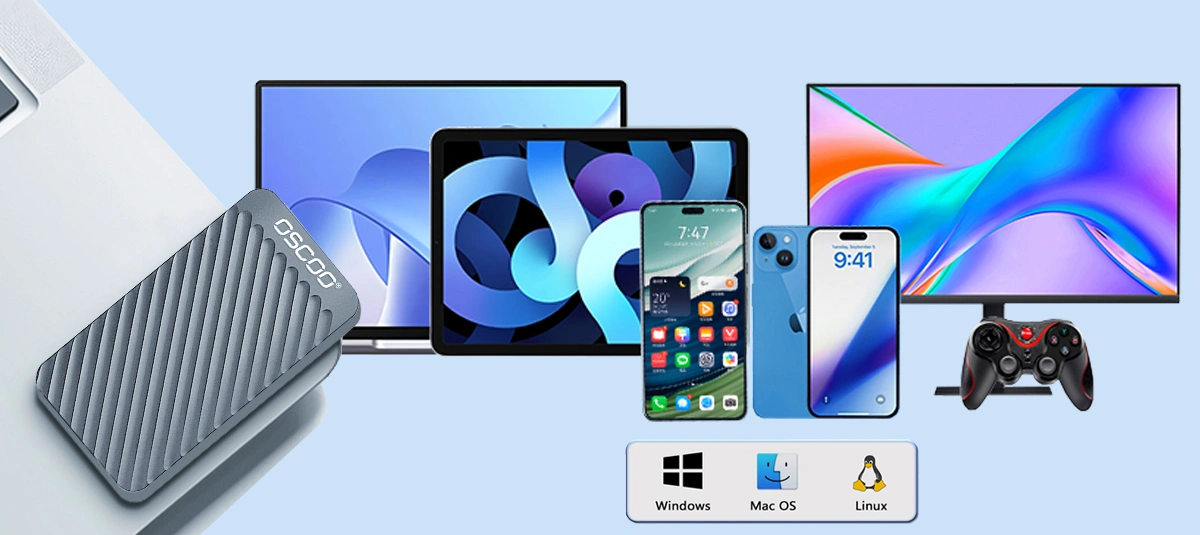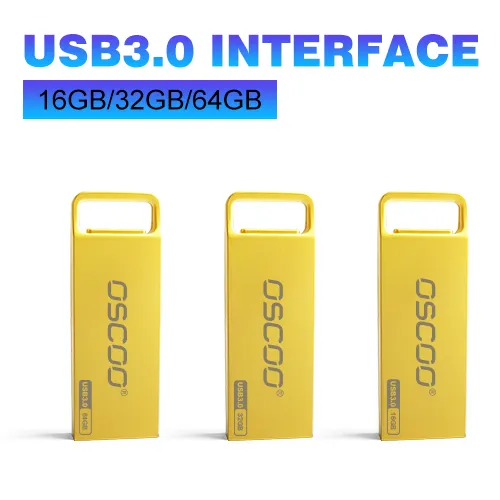
Have you ever waited endlessly for a large video file to transfer? Worried about your external hard drive failing and losing important data after a minor bump? While traditional Hard Disk Drives (HDDs) offer reliable capacity, their slow read/write speeds, extreme sensitivity to vibration, and bulky size struggle to keep up in today’s fast-paced, mobile world. The demand for faster, smaller, and more reliable portable storage is growing rapidly. Thanks to the rapid advancement of NAND flash technology and the widespread adoption of high-speed interfaces like USB 3.2/Thunderbolt, the Portable Solid State Drive (Portable SSD drive or PSSD) has emerged. It revolutionizes data storage by combining the blazing-fast performance of desktop SSDs with the extreme portability of mobile devices, making it the ideal choice for modern data storage and transfer.
Table of Contents
ToggleWhat is a Portable SSD?
A Portable Solid State Drive (PSSD) is an external storage device that uses NAND flash memory chips for storage, connects to devices via high-speed interfaces like USB or Thunderbolt, and provides high-capacity, high-performance data storage and transfer in a portable form factor. Its core features are: no moving parts, reliance on flash memory, high-speed interfaces, and portability. Simply put, it’s a professional mobile storage solution that combines the speed of an internal SSD with a portable case and universal connectors. Compared to USB flash drives and portable HDDs, it offers significant advantages in speed, capacity, reliability, and durability.
Basic Structure of a Portable SSD
While you don’t need to know every electronic component, understanding the core parts of a PSSD helps grasp how it works. A typical portable SSD consists of these key elements:
- PCB (Printed Circuit Board): The green baseplate that holds and connects all electronic components.
- NAND Flash Memory Chips: The core storage components where data is saved electronically.
- Controller Chip: The “brain” of the SSD, managing data reading/writing, error correction, and storage space allocation.
- Bridge Controller Chip: Converts the internal storage protocol (like SATA or NVMe) into an external interface protocol (like USB or Thunderbolt) that your computer understands.
- Physical Interface: The actual port connecting to your computer or device (usually USB Type-C or Type-A).
- Enclosure: Provides physical protection (shock, dust, heat dissipation) and gives the product its final shape, often made of metal or strong plastic.
Capacity and Speed: Key Features of a Portable SSD

- Capacity: The mainstream capacity range for portable SSDs today is 500GB to 2TB (OSCOO MD006 PSSD even provides a capacity of 4TB), easily covering needs like daily document backups, photo/video storage, and medium-sized game libraries. The 1TB capacity is the most popular choice, striking the best balance between price and practicality.
- Transfer Speed: The actual speed of a PSSD isn’t determined by just one thing; it’s constrained by three hardware layers:
- Internal Protocol & Drive Performance (The Engine): SATA protocol PSSDs have a speed limit around 550MB/s. NVMe protocol (PCIe) PSSDs (e.g., OSCOO MD008, OSCOO D8) have much greater potential, far exceeding SATA. NVMe is key for high speeds but needs a fast external connection.
- Bridge External Interface (The Gateway): This sets the theoretical speed limit:
- USB 3.2 Gen 1 (5Gbps): ~500MB/s limit.
- USB 3.2 Gen 2 (10Gbps): ~1000MB/s limit (Standard for high-speed NVMe PSSDs).
- USB 3.2 Gen 2×2 / USB4 / Thunderbolt (20Gbps+): 2000MB/s+ limit.
- Connected Device’s Interface (The Bottleneck): The real-world speed cannot exceed the maximum speed supported by the port on your computer, phone, or other device. Example: A 10Gbps external SSD plugged into a 5Gbps USB port means Max speed is ~500MB/s. Always check your device’s port specifications!
Advantages and Disadvantages of Portable SSDs
Portable solid state drives offer significant improvements but have limitations:
Advantages
- Blazing Fast Speeds: Dramatically faster (often 10x+) than portable HDDs.
- Shock & Vibration Resistant: Highly resistant to bumps, drops, and shocks (no moving parts).
- Silent Operation: Zero noise (electrical signals only).
- Compact & Lightweight: Significantly smaller and lighter than HDDs, incredibly portable.
- Lower Power Consumption & Heat: Generally use less power and generate less heat than HDDs (NVMe models can get warm under heavy load).
- Consistent Performance: Speed remains stable, unaffected by file fragmentation.
Disadvantages
- Higher Cost: Noticeably higher than portable HDDs.
- Difficult/Expensive Data Recovery: Much harder, costlier, and less likely to succeed than HDDs if physically damaged.
- Limited Write Endurance: NAND flash wears out after write cycles (measured by TBW). But that’s sufficient for years of typical use.
- Data Retention Risk: Risk of data loss if stored unpowered for years, especially in hot/humid environments (low risk for regular use).
- Potential Heat : NVMe PSSDs can generate significant heat during sustained heavy use.
Classifying Portable SSDs
Find the perfect portable SSD by matching it to your needs:
- Speed-First: Raw performance (1000MB/s+, up to 2000MB/s+). NVMe, USB 3.2 Gen 2 / Thunderbolt, metal cases. Ideal for: Video editors, pro photographers, gamers, programmers/designers.
- Balanced & Practical: Best mix of speed (500-1000MB/s), capacity (1-2TB), size, value. Ideal for: Students, office workers, families, photography enthusiasts.
- Ultra-Portable: Extremely small/light (credit card size, <30g). Speeds (~400MB/s+) for everyday files. Ideal for: Business travelers, teachers, document carriers.
- Rugged & Durable: Water/dust/shock resistance (IP/MIL-STD). Rubber armor. Reliable speeds (<1000MB/s). Ideal for: Outdoor pros, field workers, adventurers.
- High-Capacity Archive: Massive storage (4TB-8TB+). Ideal for: Media/game libraries, large backups, cold data (rarely accessed but kept) storage.
What is Portable SSD Used For

What are portable SSDs used for? They are excel in scenarios needing speed, portability, and reliability:
- Professionals Handling Large Files: Fast transfer/editing of RAW photos, 4K/8K video.
- Gamers Expanding Storage: Add space for PS5/Xbox games or carry a portable game library.
- Portable OS/Software Drive: Run Windows/macOS or apps (e.g., Adobe suite) from the external SSD anywhere.
- Fast Backups & Recovery: Quickly back up and restore photos, documents.
- Reliable Mobile Drive: Safely carry presentations, project files for mobile professionals/students.
- High-Speed File Hub: Quickly share large files (videos, installers) between devices.
How to Choose a Portable SSD
Choose the right PSSD by focusing on key factors:
- Determine Capacity: Based on use (docs/photos/video/games), 500GB/1TB is mainstream.
- Prioritize Performance:
- Check Your Ports: Know your computer’s ports (USB 3.2 Gen? Thunderbolt?). Match the portable SSD’s interface.
- Look at Speeds: Check Sequential Read/Write (large files) & 4K Random Read/Write (system responsiveness).
- Choose Protocol: NVMe > SATA (faster, smaller, but potentially hotter/costlier).
- Consider Portability & Cooling: Size/weight matter. Metal enclosures aid cooling (crucial for fast NVMe).
- Pick Brand & Warranty: Choose reliable brands. Check warranty length (3/5 years) and TBW rating.
- Extra Features: Do you need extra features such as hardware encryption, fingerprint sensors, water/dust resistance?
- Set Your Budget: Balance capacity, speed, brand, warranty according to your budget.
Using and Maintaining Your Portable SSD
Follow these guidelines for performance and data safety:
- Safely Eject: Always “Eject” or “Safely Remove” in your OS before unplugging! Prevents data loss/hardware damage.
- Use Good Cables: Use original or certified cables. Ensure a snug connection (Type-C is reversible but must be fully inserted).
- Avoid Physical Damage: Protect from drops, crushing, or liquids. Avoid extreme heat (e.g., hot car).
- Manage Heat: Don’t cover the portable SSD during long, high-speed transfers. Let it cool if hot.
- Avoid Extreme Loads: Avoid constant max-speed writes (normal use is fine).
- Back Up Regularly: Always keep important data backed up elsewhere! PSSD data recovery is very hard.
- Format Wisely: Choose the right file system: NTFS (Windows), APFS (macOS), exFAT (cross-platform).
- Check for Updates: Check for firmware updates occasionally. Install to fix bugs or improve stability/performance.
- Power Up Stored Drives: Plug in unused drives for a few hours every 6 months to maintain data integrity.
Conclusion
Portable SSDs (PSSDs) revolutionize data storage by combining desktop SSD speed with mobile device portability. They deliver lightning-fast transfers, reliable shock resistance, and pocket-friendly convenience, making them essential for modern digital life. As capacities grow, prices drop, and USB4/Type-C becomes universal, portable solid state drives will offer even greater storage freedom. Choosing the right external SSD for your needs is a smart step towards a more efficient digital future.




